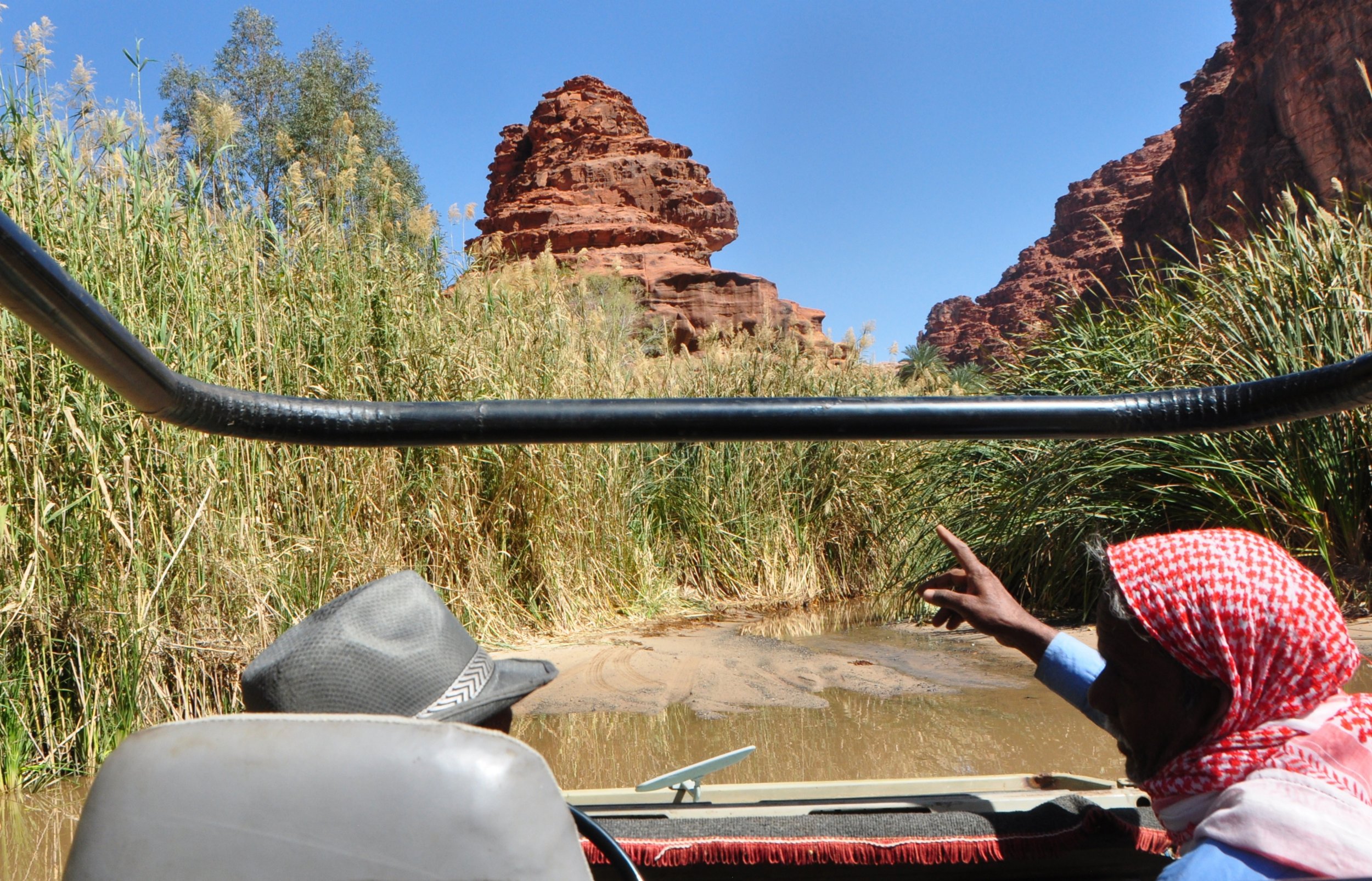
Wadi al Disah: Discovering one of Saudi Arabia’s hidden gems
When we arrive in Wadi Al Disah, we park our rental car right at the entrance. We won't get far here with our small Honda. We watch as an off-road vehicle struggles through a river basin. Only the driver's cabin is still visible, sticking out of the water like the head of a crocodile. Actually, my boyfriend and I wanted to hike through the valley. A fool's idea, as we now realise. Especially since I'm wearing a long skirt. And now? Only a few moments pass when a man brings his old Landrover to a halt next to us and wordlessly points to the back seat: Get in, please. We don't hesitate for long. It is the beginning of a breakneck drive through the Wadi al Disah in Saudi Arabia, the Valley of the Palm Trees.
A local friend had praised the Wadi as a "hidden jewel". It should not take long for the landscape to live up to his promise. As we rush through the water, a backdrop of absurd beauty spreads out around us. To the right and left, rock faces tower up in glowing shades of red, some measuring up to 500 metres. The valley nestles between them like an oasis. Year in, year out, the water flows through the west of the wadi. The stream makes palm trees, tall grasses, lemon trees and mint bushes blossom, a green garden in the middle of the desert.
If you want to explore the Wadi Al Disah, you have to travel to the northwest of Saudi Arabia. The valley is part of the Prince Mohammed bin Salman Nature Reserve, which was inaugurated in 2018 by royal decree. In the following years, millions are to flow into the preservation of the flora and fauna. If Prince Mohammed bin Salman and his "Vision 2030" have their way, tourism will be a mainstay for Saudi Arabia in the future. After all, the monarchs are aware that the oil will not gush forever.
On this Friday in March 2022, however, only a few tourists have travelled to the Valley of the Palms. Most come from inland: veiled women posing in front of palm trees and taking photos; a few families picnicking in the shade of the rock faces; young men conquering sand and water in off-road vehicles and shouting "Welcome, welcome!" at us. At the edge of the bank, a Bedouin waits for a lift. With a jerk, the Landrover comes to a halt, the old gentleman climbs into the passenger seat. He turns briefly to greet us. His smile is friendly and toothless.
The four of us drive on and remain silent. For one, because our Arabic is fragmentary at best. For another, the landscape makes us awestruck and silent. Apart from the roar of the engine, nothing can be heard. Again and again we have to duck to avoid the blows of the grasses. We are not always fast enough. In the middle of the river, the Bedouin finally signals the driver to stop. In his long robe, he climbs out of the Landrover and into the ankle-deep water. Then he disappears into the thicket of reeds. "Home," says our driver, pointing to where the old man was just visible. Home. I briefly imagine what the daily life of the Bedouins in the Valley of the Palms might be like, and then we drive on.
We never intended to travel to Saudi Arabia. Chance brought me and my boyfriend to Tabuk, a big city in the northwest of the country, about 250 kilometres from Wadi Al Disah. In the first weeks, I often felt self-conscious, sometimes lost: What would I experience as a woman in conservative Saudi Arabia? Again and again I had read and heard that the country was changing and opening up at breakneck speed.
For instance, women are no longer obliged to wear a black abaya and a headscarf. The majority of the women I meet in Tabuk still dress traditionally. Most of them wear a face veil. For me as a traveller, my time in Tabuk is like a tightrope walk between what the law allows and what society actually accepts.
In Wadi Al Disah, I leave all these worries behind. The atmosphere is relaxed, the encounters reserved and at the same time full of hospitality and warmth. After about half an hour, our driver stops again. This time he gets out, lights a cigarette and walks off leisurely. We do the same. Like trackers, we follow the trail of water until it comes to an abrupt end. The man nods contentedly and taps the rocky spot several times with a stick. Tock, tock, tock. Later we read that the water springs from an unknown source in the middle of the valley. As if from nowhere.
The beginning of the river course is also the turning point of our journey. On the way back to the car park, we meet a few camels - and a hiker in wet trousers who has obviously not been deterred by the water. His face shows the satisfied smile of a traveller who has found a hidden gem. We smile back.
Read more: The text has first been published on the German travel blog Reisedepeschen in May 2023. Click here to read the full article (German).
Pictures: John Goodwin






